Introduction
Have you ever been curious about how we came up with best practices in operations? Here’s an overview of how the last couple hundred years of advances have shaped modern day operations.
The Industrial Revolution & Scientific Management
1776: Adam Smith writes “The Wealth of Nations” where he describes the concept of “division of labor”
1760–1840: The Industrial Revolution gathers steam as machines take over more manufacturing processes previously done by hand. In the two centuries since this period, the world’s average per capita income has increased over 10-fold, while the world’s population has increased over 6-fold.
1911: Frederick Winslow Taylor publishes “The Principles of Scientific Management” for the American Society of Mechanical Engineers. The work advocates the “enforced standardization of methods, enforced adoption of the best implements and working conditions, and enforced cooperation” in order to improve efficiency. Although hugely unpopular with workers at the time and now considered largely obsolete, Taylor’s work laid the foundation for modern industrial engineering.
1913: Henry Ford introduces moving assembly belts into plants producing “Model T” cars in order to increase efficiency. By 1916, the car cost less than half of what it cost in 1908.
1920s: Walter A. Shewhart at Bell Laboratories pioneers the use of Statistical Process Control (SPC). SPC focused on proactively detecting and preventing manufacturing issues before they became problems — an advantage over methods like inspection which meant retroactively throwing out defective products.
Advances in Quality Management & Early Computing
1940s-1970s: Japanese engineers Taiichi Ohno, Shigeo Shingo and Eiji Toyoda are credited with developing the Toyota Production System — sometimes called “Just in Time Manufacturing”
1941: Conrad Zuse develops the Z3, often considered the world’s first digital computer. Developments in computer technology advanced rapidly in the 40s and 50s. These computers took up an entire room and could only perform basic math calculations.
1950s: Dr. W. Edwards Deming, an American statistician who had worked with Walter Shewhart, trains hundreds of Japanese engineers and businessmen in SPC and concepts of quality. Joseph Juran, a Romanian American engineer also influenced by Shewhart’s work, moves to Japan to teach quality management methods.
1970s: Japan considered the world leader in quality.
Quality & process improvement methods start to splinter and era of digital process management is born
1980s: America has a crisis of confidence as Japan’s economy roars ahead and American-made products are largely seen as inferior in quality. American TV network NBC runs a documentary called If Japan Can, Why Can’t We?; this popularized the works of Dr. W. Edwards Deming in the West.
1980s: FileNet develops a digital workflow management system designed to route scanned documents through a predefined process. This early system — later acquired by IBM — is often cited as the precursor to modern business process management (BPM) Software.
1986: Engineers working at Motorola pioneer the use of Six Sigma, a new technique for process improvement. Six Sigma uses statistical methods to identify causes of and then reduce variation (seen as the cause of problems that can lead to defective products or services ) in processes. Although similar to SPC, Six Sigma, was credited for moving quality management out of being just a bunch of statisticians in a backroom.
1990: James Womack, Daniel Roos and Daniel T. Jones publish The Machine That Changed the World about the Toyota Production System. The book looked at how the company’s system of “Lean” production produced superior results to those of traditional mass manufacturing.
1993: Michael Hammer and James A. Champy publish Reengineering the Corporation: A Manifesto for Business Revolution, which sparked off a fervor of Business Process Reengineering (BPR) initiatives in Fortune 500 companies. In contrast to TQM or Lean, BPR focused on radical transformation rather than iterative, continuous improvement of processes. By the late 90s, BPR had largely fallen out of fashion.
1980s-1990s: Advances in computer technology and processing speed mean that Personal Computers (PCs) begin to experience widespread adoption by both companies and individuals.
1986: Dr. Deming publishes “Out of the Crisis” (originally published as Quality, Productivity and Competitive Poison in 1982) where he proposes a management theory based on his famous 14 points.
1990: Analyst firm Gartner coins the acronym ERP — “Enterprise Resource Planning.” By the mid-1990’s ERP tools handled all sorts of back office processes and data including accounting, HR and maintenance as well as front office processes supported by CRM (Customer Relationship Management). Thus begins the digitization of enterprise data and processes.
1990s: Many companies adopt Total Quality Management (TQM) — a method similar to Six Sigma but also incorporating aspects of the Japanese system of continuous improvement.
1995: Jack Welch, CEO of General Electric, makes Six Sigma a key part of managing the company. By the late 1990s, the majority of Fortune 500 organizations had begun Six Sigma initiatives to reduce costs and improve quality.
Era of Business Process Management
2000s: Gartner coins the term “Business Process Management Suite” to refer to a vast array of software applications that deal with processes (whether carried out by machines or people). The term “workflow” falls out of fashion in IT circles (although some argue it made a comeback in the late 00’s).
2000s: Business Process Management software advances to handle a wide range of functionality from process modeling, management through to reporting and analytics.
2007: BusinessWeek runs an article entitled Six Sigma: So Yesterday? about how major companies like Home Depot, GE, and 3M, were either abandoning or reducing their Six Sigma programs.
2012: Gartner coins the term “intelligent Business Process Management” (iBPM) to refer to BPM Suites that include support for analytics and complex event processing.
2012: Forrester coins the term “Smart Process Applications” to refer to BPM software that supports collaborative processes and incorporates data, analytics, and content.
2010s-2020s: Companies begin incorporating AI functionality to automate certain tasks or entire processes.







.avif)
.avif)








